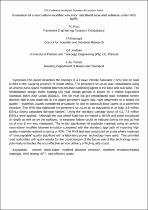 ResearchSpace
ResearchSpace
Evaluation of a nano-silane-modified emulsion stabilised base and subbase under HVS traffic
JavaScript is disabled for your browser. Some features of this site may not work without it.
- ResearchSpace
- →
- Research Publications/Outputs
- →
- Conference Publications
- →
- View Item
| dc.contributor.author |
Rust, FC

|
|
| dc.contributor.author |
Akhalwaya, Imraan

|
|
| dc.contributor.author |
Jordaan, GJ

|
|
| dc.contributor.author |
Du Plessis, L

|
|
| dc.date.accessioned | 2019-11-18T05:50:18Z | |
| dc.date.available | 2019-11-18T05:50:18Z | |
| dc.date.issued | 2019-10 | |
| dc.identifier.citation | Rust, F.C., Akhalwaya, I., Jordaan, G.J. & Du Plessis, L. 2019. Evaluation of a nano-silane-modified emulsion stabilised base and subbase under HVS traffic. In: 12th Conference on Asphalt Pavements for southern Africa, Sun City, South Africa, 13-16 October 2019 | en_US |
| dc.identifier.uri | https://www.capsaconference.co.za/wp-content/uploads/2019/06/CAPSA-2019-Submitted-Papers.pdf | |
| dc.identifier.uri | http://hdl.handle.net/10204/11220 | |
| dc.description | Presented in: 12th Conference on Asphalt Pavements for Southern Africa, Sun City, South Africa, 13-16 October 2019 | en_US |
| dc.description.abstract | This paper describes the findings of a Heavy Vehicle Simulator (HVS) test on road D1884 in the Gauteng province of South Africa. The pavement structure was rehabilitated using an anionic nano-silane modified bitumen emulsion stabilising agent in the base and sub-base. The rehabilitation design traffic loading (20 year design period) is based on 3 million Equivalent Standard 80kN Axle Loads (ESALs). The 50 year old pre-rehabilitated road exhibited severe distress with in-situ materials in the upper pavement layers that have weathered to a tested G8 quality – materials usually considered unsuitable for use in base/sub-base layers of a pavement structure. The HVS test subjected the pavement structure to an equivalent of at least 3.5 million ESALs (using calculated damage factors). Using the standard damage factor of 4,2, 7.5 million ESALs were applied. Although the dual wheel load was increased to 80 kN and water introduced (in depth as well as on the surface), no structural failure could be induced during the test (a final rut of only 8 mm was measured). The in-situ stabilisation of available materials using an anionic nano-silane modified bitumen emulsion compared with the standard approach of importing high quality materials realised a saving of 43%. The HVS test was conducted on a site where materials of “unacceptable” quality stabilised with a laboratory proven technology were used. This provided road authorities with quick results for the consideration of the future use of this technology which potentially embodies the cost-effective service delivery of high-quality roads. | en_US |
| dc.language.iso | en | en_US |
| dc.relation.ispartofseries | Workflow;22803 | |
| dc.subject | Anionic nano-silane modified bitumen emulsion | en_US |
| dc.subject | Cost-effective roads | en_US |
| dc.subject | Heavy Vehicle Simulator | en_US |
| dc.subject | HVS | en_US |
| dc.subject | HVS testing | en_US |
| dc.subject | Modified emulsion-treated materials | en_US |
| dc.title | Evaluation of a nano-silane-modified emulsion stabilised base and subbase under HVS traffic | en_US |
| dc.type | Conference Presentation | en_US |
| dc.identifier.apacitation | Rust, F., Akhalwaya, I., Jordaan, G., & Du Plessis, L. (2019). Evaluation of a nano-silane-modified emulsion stabilised base and subbase under HVS traffic. http://hdl.handle.net/10204/11220 | en_ZA |
| dc.identifier.chicagocitation | Rust, FC, Imraan Akhalwaya, GJ Jordaan, and L Du Plessis. "Evaluation of a nano-silane-modified emulsion stabilised base and subbase under HVS traffic." (2019): http://hdl.handle.net/10204/11220 | en_ZA |
| dc.identifier.vancouvercitation | Rust F, Akhalwaya I, Jordaan G, Du Plessis L, Evaluation of a nano-silane-modified emulsion stabilised base and subbase under HVS traffic; 2019. http://hdl.handle.net/10204/11220 . | en_ZA |
| dc.identifier.ris | TY - Conference Presentation AU - Rust, FC AU - Akhalwaya, Imraan AU - Jordaan, GJ AU - Du Plessis, L AB - This paper describes the findings of a Heavy Vehicle Simulator (HVS) test on road D1884 in the Gauteng province of South Africa. The pavement structure was rehabilitated using an anionic nano-silane modified bitumen emulsion stabilising agent in the base and sub-base. The rehabilitation design traffic loading (20 year design period) is based on 3 million Equivalent Standard 80kN Axle Loads (ESALs). The 50 year old pre-rehabilitated road exhibited severe distress with in-situ materials in the upper pavement layers that have weathered to a tested G8 quality – materials usually considered unsuitable for use in base/sub-base layers of a pavement structure. The HVS test subjected the pavement structure to an equivalent of at least 3.5 million ESALs (using calculated damage factors). Using the standard damage factor of 4,2, 7.5 million ESALs were applied. Although the dual wheel load was increased to 80 kN and water introduced (in depth as well as on the surface), no structural failure could be induced during the test (a final rut of only 8 mm was measured). The in-situ stabilisation of available materials using an anionic nano-silane modified bitumen emulsion compared with the standard approach of importing high quality materials realised a saving of 43%. The HVS test was conducted on a site where materials of “unacceptable” quality stabilised with a laboratory proven technology were used. This provided road authorities with quick results for the consideration of the future use of this technology which potentially embodies the cost-effective service delivery of high-quality roads. DA - 2019-10 DB - ResearchSpace DP - CSIR KW - Anionic nano-silane modified bitumen emulsion KW - Cost-effective roads KW - Heavy Vehicle Simulator KW - HVS KW - HVS testing KW - Modified emulsion-treated materials LK - https://researchspace.csir.co.za PY - 2019 T1 - Evaluation of a nano-silane-modified emulsion stabilised base and subbase under HVS traffic TI - Evaluation of a nano-silane-modified emulsion stabilised base and subbase under HVS traffic UR - http://hdl.handle.net/10204/11220 ER - | en_ZA |





